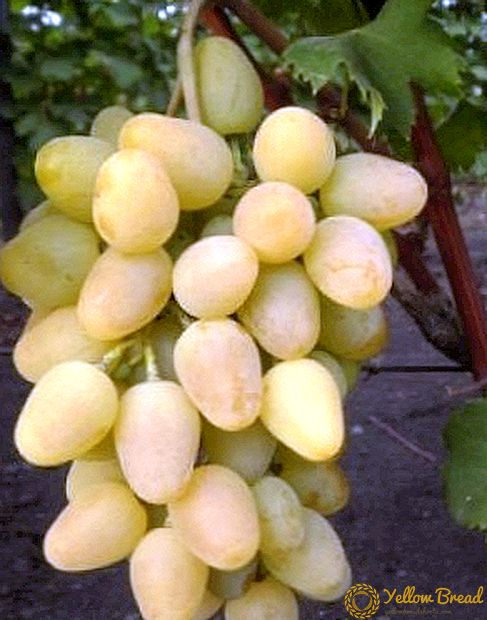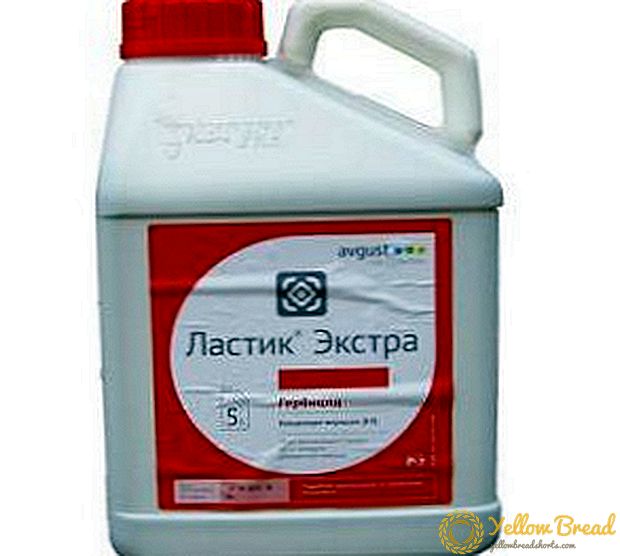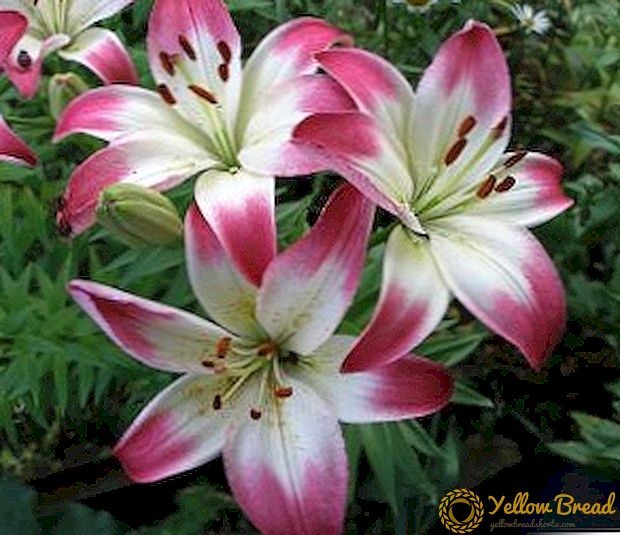 Today we will talk about growing Chabo carnation in the open field. Many flower growers liked this flower because from the first days of summer until late autumn the plant pleases with flowers that can be cut as a gift or used to create compositions.
Today we will talk about growing Chabo carnation in the open field. Many flower growers liked this flower because from the first days of summer until late autumn the plant pleases with flowers that can be cut as a gift or used to create compositions.
Carnation Shabo grows up to 60 cm, and for one growing season gives up to 35 flower shoots. Flowers turn out bright, large (up to 8 cm in the diameter), a various color. The height of peduncles varies from 25 to 35 cm.
- Growing carnations Shabo through seedlings
- Terms of sowing seedlings
- Soil for growing seedlings
- Seeding containers
- Sowing seeds for seedlings
- Conditions for germinating seeds
- Care for young plants
- Pickling seedlings of carnations
- Hardening seedlings
- Planting seedlings of carnations Shabo in open ground
- The timing and choice of places for planting seedlings
- Planting plantation seedlings
- Caring for chabo cloves
- Do I need a pinch?
- How to conduct watering
- Top dressing carnations
- Shabo carnation for cutting
- Diseases and pests cloves Shabo
- Carnation Shabo in winter
- Cutting cloves Shabo
Growing carnations Shabo through seedlings
Next, we will talk about how to plant carnations for Shabo on seedlings, and also tell you about the main intricacies of this process that will help grow viable seedlings from seeds.
Terms of sowing seedlings
 Depending on the specific time of the year, there are 2 options for planting seeds of chabot cloves: in December and February.
Depending on the specific time of the year, there are 2 options for planting seeds of chabot cloves: in December and February.
Since the carnation blooms 150 days after sowing, early planting is permissible if you want very early flowers, but only if the climate is appropriate.
Planting in December is carried out only in special greenhouses, in which it is possible to maintain the optimum temperature, humidity and lighting.
Standardly, sowing of seeds is carried out in mid-February in order to admire various flowers in early summer.
Soil for growing seedlings
Plant seeds should be sown in specially prepared soil. In this case, even if you have the best black soil on your flowerbed, you cannot use it. Special soil mixture prepared from turfy ground, peat, sand and humus.
It is recommended to use river sand, and humus needs to be ground to a powdery state (it is impossible to lay large layers).
This substrate gives the germinated seeds the necessary nutrients and has good drainage properties.
Seeding containers
 Growing Chabot carnations from seeds should be done in special containers that will give the young plant enough space for root growth and, with it, will not trap moisture in the soil.
Growing Chabot carnations from seeds should be done in special containers that will give the young plant enough space for root growth and, with it, will not trap moisture in the soil.
Special seedlings are often used for sowing seeds (can be purchased at flower shops). Containers should be low (up to 6 cm in height), wide and, ideally, divided into several sections.
It is not recommended to buy plastic containers, as many manufacturers cunning and use toxic plastic that releases poisons during prolonged contact with moisture.
Sowing seeds for seedlings
Sowing the seeds of carnations Shabo at home is a simple task. It is important to follow the instructions, and small seeds, after a few months, will turn into young seedlings.
Start growing with the purchase of growth stimulant. This tool will not only help the seeds to take root faster, but also provide better survival and germination. Here any preparation will be suitable to accelerate the growth of the roots of flowers.
 Before sowing, seeds are soaked in the aforementioned product for 4-5 hours (use the dosage indicated on the package), then spread on the prepared substrate and sprinkled with calcined sand (sand should cool before planting). After that, moisten the soil with warm water.
Before sowing, seeds are soaked in the aforementioned product for 4-5 hours (use the dosage indicated on the package), then spread on the prepared substrate and sprinkled with calcined sand (sand should cool before planting). After that, moisten the soil with warm water.
Conditions for germinating seeds
In order for the planting material to ascend, you need to create all the conditions for it, especially in the first days after planting. Thus, forms with seeds must be moved to a room with a temperature of +23 23С… +25 ˚С, in which there should not be any dampness or any fungi.
In addition, immediately after planting, the container should be covered with a film, which is removed for ventilation, if condensation has formed on it (at least 1 time per day). In such a microclimate, seeds germinate very quickly and seedlings can be waited in a week.
Care for young plants
We turn to an equally important stage - the care of seedlings of carnations Shabo.
As soon as the first shoots appeared, the containers are transferred to a bright, cool place (the temperature should be within +14 ˚С… +16 С).
 After the emergence of shoots need to monitor the humidity of the substrate.
After the emergence of shoots need to monitor the humidity of the substrate.The soil should be wet, as strong drying or over-wetting is detrimental to young plants.
Watering is carried out with a spray early in the morning.
It is worth remembering that the plants need constant airing. In a musty room, without access to fresh air, the cloves will grow more slowly and quickly lose their leaf color.
Pickling seedlings of carnations
In the process of growth of young seedlings, 2 picks of Shabo carnation seedlings are performed. The first is carried out when the plant acquires two true leaves. Transplantation into individual containers is carried out for two reasons: in order to increase the amount of free space for the horse system, or trying to avoid weaving roots with a number of growing carnations.
 The second pick is carried out at the end of March, at the stage of 4 true leaves. For each flower, a small pot with a diameter of about 10 cm is selected, filling it with the same mixture that was used for sowing seeds. Also, you can add a little more humus, if the cloves turned out weak. Plants should be transferred to a new place without separating the earthen coma.
The second pick is carried out at the end of March, at the stage of 4 true leaves. For each flower, a small pot with a diameter of about 10 cm is selected, filling it with the same mixture that was used for sowing seeds. Also, you can add a little more humus, if the cloves turned out weak. Plants should be transferred to a new place without separating the earthen coma.
Hardening seedlings
Hardening seedlings produced after the second transplant. Carnations contain at a temperature of +13 …С… +15 ˚С, and at night they lower this figure to +10 С. Such temperatures are not detrimental to flowers, but on the contrary, they stimulate the protective system of plants: they suffer less after transplantation into open ground.
Planting seedlings of carnations Shabo in open ground
 So it's time to move the cloves of Shabo to a flower bed. In this section we will tell you about the scheme of planting young plants, let's talk about the choice of optimal timing and place for planting. Before,How to transfer the plant from the house to the street you need to make sure that it is strong enough, has the natural color of the leaves and the stem, and also has grown enough for transplanting.
So it's time to move the cloves of Shabo to a flower bed. In this section we will tell you about the scheme of planting young plants, let's talk about the choice of optimal timing and place for planting. Before,How to transfer the plant from the house to the street you need to make sure that it is strong enough, has the natural color of the leaves and the stem, and also has grown enough for transplanting.
It is worth remembering that the timing of the transplant is directly dependent on the weather outside the window, so you need not only to follow the instructions, but also to check with the temperature.
The timing and choice of places for planting seedlings
In early May, seedlings can be transferred to the open ground. If it is rainy or too cold outside, then the transfer is delayed until the end of the month. However, you need to remember that the latest date for planting seedlings on the site is the first week of June.
 Place for flowers, choose a sunny, well protected from the wind.
Place for flowers, choose a sunny, well protected from the wind.
Planting cloves on the north or north-east side is not recommended.
For cloves Shabo suitable nutrient neutral soil.
Of course, it is unnecessary to specially deliver black soil, but if the soil is very “poor”, then more natural fertilizers should be added before planting.
Planting plantation seedlings
It is important not only to choose a suitable place, but also to plant the plants correctly so that the planting is not thick or too rare.
Gardeners recommend planting carnations according to a pattern of 25x25 cm or 30x20 cm. According to this plan, about 14 flowers can be placed per 1 m².
This is the optimal distance, which provides opportunities for growth and increase of the root system, and, at the same time, the planted plants do not quickly deplete the soil. 
Caring for chabo cloves
We turn to caring for Chabot cloves. It would seem that the most difficult stage has already been passed, but even the strongest flowers can quickly die without proper care. It is worth noting that if at the time of planting, organic fertilizers were not applied to the substrate, then this item should be given special attention in the process of growing carnations.
Do I need a pinch?
Let's begin, perhaps, with pinching a chabot clove. This procedure should be carried out if you want to get huge buds.
Pinching is the removal of all stepsons (up to 6 knots) and side buds. Most often, this action is carried out to obtain lush inflorescences on bouquets. If you are not going to grow flowers only to decorate the garden, then nipping is not necessary. 
How to conduct watering
Watering the plants is carried out as the topsoil dries out, and it is better to use a hose or to water the bucket to moisten the soil.
It should be understood that when watering the moisture goes into the lower layers of the soil, where the roots of flowers do not reach. Therefore, you need to pour in water as much as the soil can absorb. Based on the experience gained, in subsequent times, you will be able to use just such a volume of water.
It is necessary to water a plant not according to a certain schedule, but depending on the weather. If it is too hot or windy, then you need to water more often. If it rained or there was fog, it is better to completely abandon watering.
Top dressing carnations
Carnation badly needs fertilizing, on which depends not only the condition of the plant, but also the quality of flowers.
Prior to flowering, nitrogenous fertilizers are placed in the ground (15 g per 1 m²). As soon as the first buds appeared, potassium was added to the nitrogen.
 In the form of nitrogen fertilizers, you can use a 0.1% solution of ammonium nitrate, which is sprayed above-ground part of the flower. Nitrogen starvation is manifested in the form of whitening the base of the leaves, which is a very good "sensor" for the owners.
In the form of nitrogen fertilizers, you can use a 0.1% solution of ammonium nitrate, which is sprayed above-ground part of the flower. Nitrogen starvation is manifested in the form of whitening the base of the leaves, which is a very good "sensor" for the owners.
Fertilizing flowers should be no more than once every 2 weeks. It is also worth remembering that in no case should fresh organic matter (manure) be given to cloves.
Shabo carnation for cutting
If the carnation was planted for future cutting of peduncles, then be sure to read the nipping point. It is worth remembering that the more buds on one plant, the smaller they will be.
It is best to cut several shrubs for cutting, on which 1 peduncle develops. In this way you will get a huge strong bud that will have a good smell and stay in a vase for a long time.
For cutting fit half open buds. They are cut off early in the morning or late in the evening under 6 knots. Further for three days, cut flowers can be kept indoors at a temperature of +10 ˚С… +12 ˚С.So flower stalks will not lose their flavor or beauty.
Diseases and pests cloves Shabo
 It is worth talking about the diseases and pests of cloves. Most diseases flower "acquires" due to improper care or problems in the seedling. The parasites mainly settle on diseased or weakened plants, but agricultural technology and the cleanliness of the site play an important role.
It is worth talking about the diseases and pests of cloves. Most diseases flower "acquires" due to improper care or problems in the seedling. The parasites mainly settle on diseased or weakened plants, but agricultural technology and the cleanliness of the site play an important role.
The source of infection is infected plants or plant debris. If the weather is hot, then the disease begins to progress.
 To get rid of the disease, clove Shabo need to be sprayed 3 times with a break of 12-15 days Bordeaux liquid (1%) or chlorine dioxide (0.25%).
To get rid of the disease, clove Shabo need to be sprayed 3 times with a break of 12-15 days Bordeaux liquid (1%) or chlorine dioxide (0.25%).
Use of folk remedies to get rid of the fungus is not recommended.
Fusarium A common disease of garden plants, which is also caused by a fungus. The disease affects the vascular system, after which the clove withers and dries. Symptoms of the disease: the stem becomes red or brown, the leaves turn yellow, the plant appears dried.
The disease is transmitted through diseased plants and through the soil.
Unfortunately, it is impossible to rid the clove of this disease. Sick plants are immediately destroyed (burned), and all other cultures in the garden are treated with fungicides of directional action.
 Rust. Another fungal disease that damages leaves, stems and flower stalks. To determine the disease can be on the brown swelling and yellow spots around the affected area. The appearance of such a problem indicates an excessively high soil moisture, an excess of nitrogen, or a lack of potassium.
Rust. Another fungal disease that damages leaves, stems and flower stalks. To determine the disease can be on the brown swelling and yellow spots around the affected area. The appearance of such a problem indicates an excessively high soil moisture, an excess of nitrogen, or a lack of potassium.When signs of disease appear, the cloves need to be treated with fungicides.
Now let's pay attention to the pests of the flower. Carnation mostly plague Bears, earwigs and spider mites.
Medvedki they are destroyed in different ways: a soap solution is poured into the minks, pits are dug and filled with manure, insects are etched with directional pesticides. However, keep in mind that it is not so easy for Medvedka to withdraw from the site, so when she appears, all the flowers in the garden will suffer.
Earwig, pincer or "pinch" - a familiar insect that, at first glance, does not pose a threat to plants. However, this parasite feeds on all the above-ground parts of the carnation: leaves, stem, buds and flowers. Therefore, one day you can find spoiled inflorescences, which were going to cut a gift.
 The following insecticides are used to destroy the insect: Iskra, Fufanon, Karate. You can also use traditional methods or traps. We recommend using pesticides, because the flowers will not be eaten, which means that insecticides do not carry any threat to human life.
The following insecticides are used to destroy the insect: Iskra, Fufanon, Karate. You can also use traditional methods or traps. We recommend using pesticides, because the flowers will not be eaten, which means that insecticides do not carry any threat to human life.
Spider mite represented by small spiders of red, white or light yellow color, which are shaped like a tick. Their appearance contributes to a warm dry climate.Insects feed on plant sap, thereby weakening it. The activity of the tick is displayed on the plant in the form of translucent leaves or whitish dots.
To get rid of the tick, it is enough to spray the planting of carnations with the drug "Aktelik". If the number of bushes is small, then you can try old-fashioned methods (an infusion of onion peel, infusion of garlic or tobacco).
Carnation Shabo in winter
Many gardeners at this point asked themselves the question: "Is not the carnation is an annual plant?". Fortunately, the clove of Chabot can be saved for several years. This simplifies a lot, since you do not have to face the hassles associated with planting and growing seedlings every year.
Therefore, we will tell you how to save the plant in winter.
Unfortunately, in the open ground Shabo carnation cannot winter. Therefore, when the temperature outside the window drops to +10 С in the daytime, all the flowers are dug up together with the earthy clod and sit in separate pots, where they will wait the winter.
Thus, you will not only save the flower, but also increase the number of indoor plants. In warmth the carnation can bloom until late autumn, delighting you with luxurious buds and pleasant aroma.
After the bush has blossomed, each shoot is shortened to 2/3 of its length, the peduncles are cut, and the pot is transferred to a cool place (the temperature should be the same as when hardening the seedlings).
Cutting cloves Shabo
In the final part of the article we will discuss the reproduction of Shabo carnation by cuttings.
Cuttings are cut from a bush that has overwintered in the house. That is, we use the “old” carnation as a mother bush for receiving planting material. To do this, in February such a flower starts to be watered abundantly so that it starts growing. In March, axillary shoots are longed, 6–7 cm long, cutting off the upper and lower parts.
 At the interstice, make an oblique cut and plant the cutting in wet sand, but before that it is recommended to place it in the root growth stimulator in order to increase the chance of germination.
At the interstice, make an oblique cut and plant the cutting in wet sand, but before that it is recommended to place it in the root growth stimulator in order to increase the chance of germination.
After planting the stalk is covered with a jar, creating greenhouse conditions. In the first 7-9 days, the container should be in the shade, but every day you need to remove the can for ventilation and moisten the substrate.
Already at 16-18 days the cutting will germinate. After that, the bank must be removed and put the container with the handle closer to the light.
Cuttings are practiced to preserve the variety they like, but it is worth remembering that the cloves obtained from the cuttings are not as strong as those grown from seeds.
Now you know when to sow Shabo carnation on seedlings, how to save a flower in winter and get several cuttings from one bush. Use the instructions described in practice and you can grow a beautiful garden filled with the scent of multi-colored carnations.






